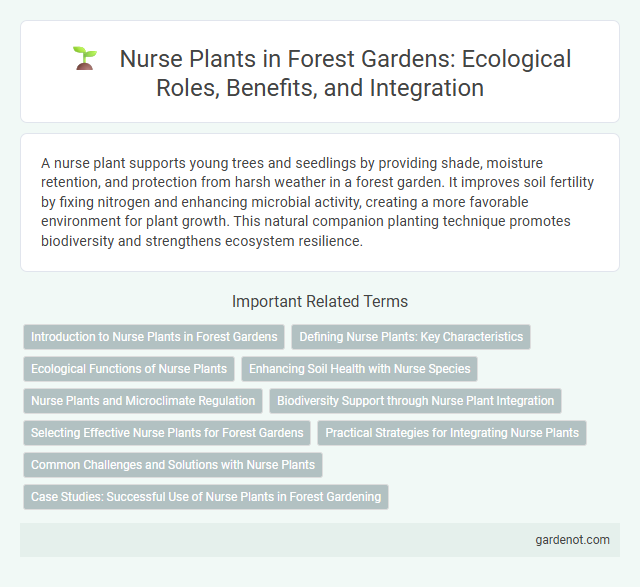A nurse plant supports young trees and seedlings by providing shade, moisture retention, and protection from harsh weather in a forest garden. It improves soil fertility by fixing nitrogen and enhancing microbial activity, creating a more favorable environment for plant growth. This natural companion planting technique promotes biodiversity and strengthens ecosystem resilience.
Introduction to Nurse Plants in Forest Gardens
Nurse plants are essential components in forest gardens, providing protective microclimates that enhance seedling survival and growth. These plants offer shade, reduce soil erosion, and improve moisture retention, creating favorable conditions for young trees and shrubs. Their presence accelerates ecosystem development and biodiversity by supporting diverse plant and animal species.
Defining Nurse Plants: Key Characteristics
Nurse plants are hardy species that create favorable microenvironments for the growth of more vulnerable plants by providing shade, moisture retention, and protection from herbivores. These plants are characterized by their ability to improve soil fertility through nitrogen fixation or organic matter accumulation and often thrive in harsh or degraded landscapes. Their structural traits and ecological functions support biodiversity and enhance forest garden resilience.
Ecological Functions of Nurse Plants
Nurse plants play a crucial role in forest garden ecosystems by enhancing soil quality through nitrogen fixation and organic matter accumulation. They provide microhabitats that protect young seedlings from harsh environmental conditions such as excessive sunlight, wind, and temperature fluctuations. Their presence promotes biodiversity by facilitating the establishment and growth of a variety of plant species, thereby improving overall ecosystem resilience.
Enhancing Soil Health with Nurse Species
Nurse plants play a crucial role in enhancing soil health by supporting nutrient cycling and improving soil structure in forest gardens. These species increase organic matter through leaf litter and root biomass, which boosts microbial activity and soil fertility. Their presence also aids in moisture retention and reduces erosion, creating a favorable environment for the growth of other plants.
Nurse Plants and Microclimate Regulation
Nurse plants play a crucial role in forest garden ecosystems by creating favorable microclimates that support the growth of more delicate species. These plants provide shade, reduce wind exposure, and help regulate soil moisture, thus stabilizing temperature fluctuations and enhancing seedling survival rates. Their presence improves soil fertility through organic matter accumulation and promotes biodiversity by facilitating habitat conditions conducive to diverse plant and animal life.
Biodiversity Support through Nurse Plant Integration
Nurse plants enhance forest garden biodiversity by creating microhabitats that support a variety of flora and fauna. Their shade and organic matter improve soil conditions, fostering the growth of understory plants and attracting beneficial insects and wildlife. This integration promotes ecosystem resilience and increases overall species richness.
Selecting Effective Nurse Plants for Forest Gardens
Selecting effective nurse plants for forest gardens involves prioritizing species that enhance soil fertility, provide shade, and offer pest protection to young plants. Nitrogen-fixing plants such as alder (Alnus spp.) and black locust (Robinia pseudoacacia) improve soil nutrient content, while fast-growing species like willow (Salix spp.) supply essential shelter from wind and harsh sunlight. Choosing nurse plants with deep root systems promotes soil aeration and water retention, fostering a resilient and productive forest garden ecosystem.
Practical Strategies for Integrating Nurse Plants
Nurse plants enhance forest garden productivity by providing shade, moisture retention, and nutrient enrichment for young seedlings. Practical strategies include selecting native nurse species with deep roots to improve soil structure and timing planting to match seedling vulnerability stages. Incorporating nurse plants in guild designs optimizes microclimates, reduces competition, and promotes biodiversity, accelerating ecosystem development.
Common Challenges and Solutions with Nurse Plants
Nurse plants often face challenges such as competition for water and nutrients with target crops, and vulnerability to pests and diseases. Solutions include selecting nurse species with complementary root structures that minimize resource competition and integrating pest-resistant varieties to protect young plants. Proper spacing and monitoring soil moisture levels enhance the survival and growth of both nurse plants and cultivated species in forest gardens.
Case Studies: Successful Use of Nurse Plants in Forest Gardening
Case studies demonstrate nurse plants significantly improve forest garden sustainability by enhancing soil fertility, promoting microclimate stability, and accelerating the growth of target crops. For example, research on nitrogen-fixing Acacia species shows increased yield in adjacent fruit trees due to enhanced soil nutrients and moisture retention. In temperate forest gardens, native shrubs like Ceanothus serve as effective nurse plants by providing shade and organic matter, leading to higher survival rates of young saplings.
Nurse plant Infographic

 gardenot.com
gardenot.com